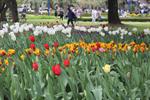
When you first plant out bulbs, you should provide them with a friable, rich, organic, well drained loam; they thrive on soil which has been prepared with rotted manure or compost prior to planting. Improve your soil with compost and make sure it is well drained; bulbs will not grow well in heavy soils with low nutrients. If you have heavy soils plant them in raised beds or pots.
Swollen roots, bulbs, corms or rhizomes are actually food storage units; the plants use photosynthesis, and also nutrients available in the soil (when in leaf - but mainly after flowering is finished), to store energy for the following season’s growth and flowering. Due to this they do not need heavy feeding when first planted as they will initially utilise this stored food supply. The best time then to fertilise bulbs that become dormant is after they have flowered. It is for this reason that you should only remove the old leaves from bulbs when they are no longer green. If you have not removed the flowers to use in flower arrangements, it can also be beneficial to remove the spent flower heads, as this will prevent the plant from putting its energy into seed creation.
Because they are all grown for flowers, they generally need larger amounts of potash than other nutrients. They usually also have a dormant period and can be susceptible to rotting if left in a moist situation during dormancy (i.e. their metabolism is slow in dormancy - this means their defence mechanisms are lower). Some bulbs in some areas may need to be lifted.
Fertilizers Appropriate for Bulbs
As indicated earlier bulbs usually have sufficient nutrients stored within the dormant tissue to produce flowers, without additional feeding; however, growth will be stronger and the bulb that forms when the plant enters dormancy again however with soil fertility.
You can get concentrated, fast acting fertilizers (which will feed more to the plant, quicker); or slower acting, long term fertilizers, and there are many possibilities in between these two extremes. Most bulbs are better with slower acting fertilisers. Usually a slower acting fertilizer is more appropriate with planting - particularly in sandy soils.
Avoid stronger fertilisers directly contacting tender tissues (e.g. leaves, new roots or the dormant bulb).
Organic fertilisers are in the main slower; as are pellet fertilisers or anything that does not dissolve readily and thoroughly in water.
Buy our ebook-
Growing and Knowing Flowering Bulbs now
Love flowering bulbs? Study a course with ACS Distance Education on
Cut Flower Bulbs: